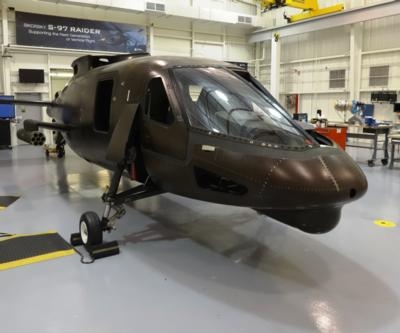Aircraft Anounced Four Years Ago Based On X2 Technology
Sikorsky Aircraft has unveiled the first of two S-97 Raider helicopter prototypes, signaling the start of activities in the program’s test flight phase and a major step toward demonstrating the new – and first – armed reconnaissance rotorcraft featuring X2 Technology designed for military missions.

“Today, Sikorsky unveiled the next generation of military rotorcraft, with capabilities and performance never seen before in our industry,” said Sikorsky President Mick Maurer. “Just four years ago, we announced plans to build the S-97 Raider and teamed with some of the best companies in the industry, understanding the need to ensure aircraft development would not falter as government defense budgets shrank in response to economic pressures. Sikorsky is proud of its leadership in this area, and of the leadership the S-97 Raider represents among the world’s military rotorcraft.”
Based on Sikorsky’s rigid X2 rotor coaxial design, the S-97 Raider helicopter features next-generation technologies in a multi-mission configuration (armed aerial scout or light assault), capable of carrying six troops and external weapons. The coaxial counter-rotating main rotors and pusher propeller provide cruise speeds up to 220 knots (253 mph), more than double the speed of conventional helicopters. Sikorsky will offer the Raider aircraft as a replacement for the U.S. Army’s OH-58D Kiowa Warrior helicopter fleet based on the Army’s future operational and financial priorities, and for the special operations platform.
“Military rotorcraft fleets need maximum performance and increased capabilities to achieve their objectives,” Maurer added. “The Raider delivers on that with its greatly improved maneuverability and speed, significantly improved high/hot hover performance, and greater range and endurance.”

The single-engine Raider features a composite airframe and a maximum gross weight of slightly more than 11,000 lbs. The aircraft will be capable of carrying an array of weapons and sensors, necessary for the mission. The cockpit will fit two pilots, seated side-by-side. The flexible cabin space will carry up to six combat-equipped troops, or additional fuel and ammunition for extended missions.
“Raider marks the first unveiling of a new relevant rotorcraft configuration in 30 years,” said Mark Miller, Vice President of Research & Engineering. “With the Raider program, Sikorsky has brought innovation to every aspect of the process, rethinking the way we design, build, test and support the product. We’ve kept a close eye on lowering development, production and support costs while increasing productivity and quality, and we are confident that the Raider is the solution for the future warfighter. We are looking forward to getting air under its tires and expanding the envelope in flight test in the coming months.”
The Raider helicopter program is 100 percent industry funded. Sikorsky provides 75 percent of the investment, and 53 principal suppliers provide the remaining funding.
(Images from file. Prototype images not yet available)
 ANN's Daily Aero-Linx (05.02.24)
ANN's Daily Aero-Linx (05.02.24) ANN's Daily Aero-Term (05.02.24): Touchdown Zone Lighting
ANN's Daily Aero-Term (05.02.24): Touchdown Zone Lighting Aero-News: Quote of the Day (05.02.24)
Aero-News: Quote of the Day (05.02.24) ANN FAQ: Contributing To Aero-TV
ANN FAQ: Contributing To Aero-TV NTSB Final Report: Cirrus Design Corp SR20
NTSB Final Report: Cirrus Design Corp SR20




